The 9 Best Under Hood Work Lights

This wiki has been updated 34 times since it was first published in March of 2017. Forget about trying to perform your vehicle's next timing belt change with a weak flashlight in one hand and your tools in the other. These under-hood work lights are specifically designed for when you need to access your engine bay in low-light conditions, illuminating the space with bright, LED bulbs. They also free up your hands, allowing you to focus on more important things. When users buy our independently chosen editorial picks, we may earn commissions to help fund the Wiki.
Editor's Notes
June 15, 2019:
Shop lights come in a wide range of styles, but once you've used them, you'll wonder how you ever got along without one of these under hood lights, especially if you spend a lot of time working on cars. They make your work so much easier by illuminating a much wider surface area, not just a spot under a narrow, dim beam. And with most of our selections, you can direct the light exactly where you want it for maximum effectiveness.
In this update, we evaluated items based on their brightness and convenience, selecting both corded and cordless (rechargeable) models. Added the NexTool NextLED as one of our top options for its good battery life (5 hours at full brightness) and its versatility--in addition to mounting it under the hood, you can break it down into two separate lights to use anywhere. Also added the SuiTech Cordless as a solid choice and a good value for the price. It also has legs to prop it up if you use it on the shop floor instead of mounted under a hood. Removed a couple of models due to concerns about their availability.
Get Under The Hood
If you opt for the former, you’ll need to purchase one with a cord that’s long enough to reach your vehicle.
A quality work light is a beacon of hope to all the mechanics out there who may be dealing with the dim conditions lurking in an engine bay. Let’s face it, even if your shop or garage lights are dazzling, the hood is going to limit their usefulness and leave you suffering in the shadows. You’re in luck, though, because the under hood work light comes in a range of styles and has many handy features that’ll take you out of the darkness in no time.
Perhaps the number one feature that any quality under hood light will have is its ability to be positioned and repositioned. For example, many have hooks on the end that swivel so that you can adjust the light to shine in any direction. Others have hooks that pull out and retract so that you can use them with hoods of various sizes. And then there are those that fold, which are an excellent option for anyone lacking in storage space or anyone who needs a portable version.
Of course, a light won’t do you any good unless you can keep it turned on and charged, and both corded and cordless versions are available. If you opt for the former, you’ll need to purchase one with a cord that’s long enough to reach your vehicle. Cordless versions can be placed just about anywhere, but they must be charged. Luckily, manufacturers offer plenty of options to make charging simple. You’ll see those that get their juice from a 12V auxiliary power outlet, USB, or regular wall plug, for example.
Then there are the extra features that you may or may not need. Some under hood work lights offer both white and red LEDs, while others have various brightness modes for working in different conditions. Don’t forget to consider the power button, as well. It may seem like a small detail, but where the on/off switch is placed and how it’s operated can make the difference between easy use and a pain in the neck.
Lumens And Watts And Volts, Oh My
When you’re buying a new work light of any kind, you’ll see and hear several important-sounding terms bandied about: watts, lumens, volts, flux capacitor . . . okay, maybe not that last one. Many people know that they need to pay attention to volts, because an electrical device needs to run from the correct power supply. For instance, if you buy a work light made for use in the United States, where homes are wired for 110 volts, and then bring it to England and try to run it off a 230-volt power supply, the device's functioning could be compromised.
LEDs are much more energy efficient than their older cousin, the incandescent bulb, and can produce more illumination with less power.
But if you’re buying a new under hood work light, the odds are good that you’ll be able to buy it, plug it into your wall, and charge it without worrying about this too much. It’s watts versus lumens that is the trickier part, as these terms are commonly confused, but can make a big difference in how helpful your light is to you.
Fortunately, it’s easy to understand the difference between watts and lumens, even without too much technical detail. Put simply, watts measure energy output, whereas lumens measure brightness. While there’s the occasional assumption that wattage will be commensurate with a light’s brightness, this is actually a myth. The disconnect between wattage and brightness is doubly true with items that use LEDs, including under hood work lights and, in fact, more and more light sources nowadays. LEDs are much more energy efficient than their older cousin, the incandescent bulb, and can produce more illumination with less power.
So, if you’re worried about how much energy your work light will consume, you’ll want to look at the wattage. If, on the other hand, you want to make sure you get the brightness you need, you’ll need to scope out the lumens, abbreviated “lm”. Many high-quality under hood lights run in the 1,000 to 1,200 lumen range, which should be amply bright for most tasks. If you’re already in a bright space, you might be able to use a version with a lower lumen rating; if your needs are more powerful, look for something with a higher lumen rating.
Safety: A Bright Idea
Having adequate lighting will not only make your time spent working under the hood easier, it could also make it safer, as it helps you prevent mistakes and breakages. After all, when you can see what you’re doing, you’re not making a guess as to what you’re cranking on and where. But there are a few other steps that pro and at-home auto mechanics should take to protect their health.
But there are a few other steps that pro and at-home auto mechanics should take to protect their health.
First, it’s imperative to ensure that you’re working to prevent fires. Chemicals need to be stored properly, away from any heat sources, including your work lights. Greasy rags need to be placed in bins, preferably made of metal or a non-combustible material. And you should always have materials on hand for putting out a blaze, including a fire extinguisher.
Next, you’ll need to keep your tools secured properly. Even if you’re working under a car, don’t leave your tools on the floor, where it’s too easy for someone to trip over them. Keep them in a tool box, and put them away when you’ve finished. True, this sounds simple enough, but the “I’ll clean up a little later” mindset is always lurking around the corner. Be sure that your implements are in good working order, too. A compromised tool can break at just the wrong time, injuring either you or someone working near you.
Finally, be extra careful about the health of your spine. Working on cars can be highly satisfying, but only if your back isn’t killing you from too much time spent hunched over an engine. Take breaks to stand up straight and practice some stretching of the neck, back, and waist. Some chiropractors even recommend that mechanics strengthen their core muscles, as a strong center can help take some of the strain off the back.














